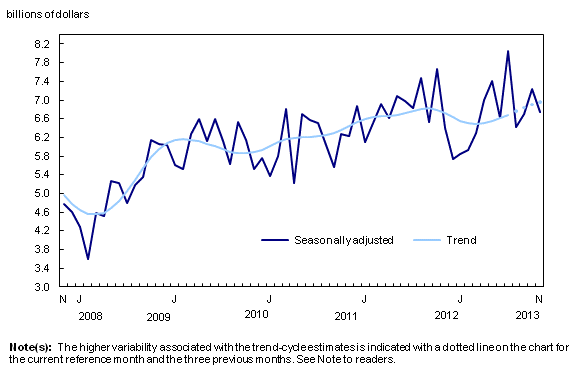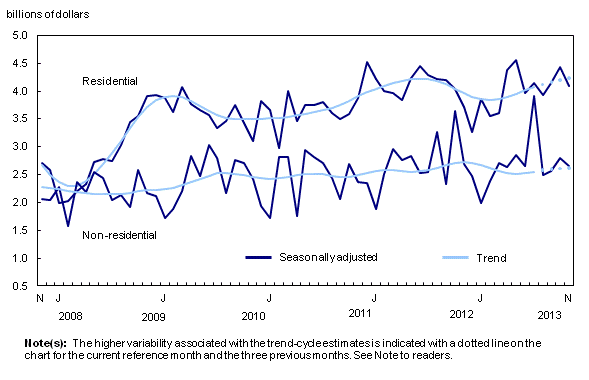Building permits, November 2013
Archived Content
Information identified as archived is provided for reference, research or recordkeeping purposes. It is not subject to the Government of Canada Web Standards and has not been altered or updated since it was archived. Please "contact us" to request a format other than those available.
Released: 2014-01-09
Contractors took out $6.8 billion worth of building permits in November, down 6.7% from October. This decline follows an 8.0% gain the previous month. Despite this monthly decrease, the total value of permits continued to show a slight upward trend on the strength of eight monthly increases since the beginning of 2013.
Lower construction intentions, particularly for the residential sector in Quebec and Ontario, were behind the decline in November.
After two consecutive monthly increases, the total value of permits in the residential sector declined 7.6% to $4.1 billion in November. Lower residential construction intentions were registered in nine provinces, led by Quebec, Ontario and Alberta. British Columbia was the lone province to show a gain in November.
Construction intentions in the non-residential sector fell 5.2% to $2.7 billion in November, following a 9.7% increase the previous month. Declines were recorded in six provinces, with Saskatchewan and Manitoba accounting for most of the decrease. Gains were recorded in four provinces, led by Ontario and Alberta.
Residential sector: Construction intentions down for both multi-family and single-family dwellings
Building permits for multi-family dwellings fell 8.7% to $1.9 billion in November, following two consecutive monthly gains. Decreases were registered in nine provinces, with Quebec posting the largest decline, followed by Ontario. British Columbia was the lone province to post a gain.
Municipalities issued $2.2 billion worth of building permits for single-family dwellings in November, down 6.7% from October. The decline followed two consecutive monthly gains. Lower construction intentions were posted in every province except New Brunswick. Alberta and Ontario accounted for most of the national decrease in November.
Canadian municipalities approved the construction of 18,173 new dwellings in November, down 3.6% from October. The decline was attributable to both multi-family dwellings, which fell 3.9% to 12,027 units, and single-family dwellings, which decreased 3.1% to 6,146 units.
Non-residential sector: Decreases in the institutional and industrial components
Canadian municipalities issued $354 million worth of institutional building permits in November, down 32.0% from October. The value of institutional building permits was down in six provinces. Ontario accounted for much of the decrease, as a result of lower construction intentions for government buildings and educational institutions. Declines were also registered for medical buildings in Alberta. All four of the Atlantic provinces posted gains in November.
The value of permits in the industrial component fell 2.2% to $455 million, marking a fourth consecutive monthly decrease. November's decline was mainly the result of lower construction intentions for transportation-related buildings in Ontario and utilities buildings in both British Columbia and Newfoundland and Labrador.
In the commercial component, the value of permits rose 1.8% to $1.9 billion, following a 25.0% increase in October. Gains in Ontario, Quebec and Alberta were enough to offset the declines registered in the remaining provinces. Office buildings in Ontario and Alberta accounted for most of the advance.
Provinces: Large declines in Quebec and Saskatchewan
The value of permits was down in eight provinces in November, led by Quebec and Saskatchewan.
The largest decline in the value of building permits was in Quebec. The decrease came mainly from lower construction intentions for multiple-family dwellings and institutional buildings. In Saskatchewan, the decline came in the wake of a strong increase in October and was the result of lower construction intentions for both residential and non-residential buildings.
The largest increase occurred in British Columbia, where a rise in multiple-family dwellings more than offset declines in every other component.
Lower construction intentions in most census metropolitan areas
The total value of permits was down in 22 of the 34 census metropolitan areas in November.
The largest declines were in Montréal, St. Catharines–Niagara and Saskatoon. In Montréal, the decrease was principally attributable to drops in multi-family dwellings and, to a lesser extent, commercial buildings. Lower intentions for institutional and commercial buildings and single-family dwellings explained the decline in St. Catharines–Niagara. In Saskatoon, commercial construction intentions and, to a lesser degree, multi-family dwellings were behind the decrease.
Toronto posted the largest increase in November, followed by Québec and Vancouver. The value of permits issued in Toronto advanced largely as a result of higher construction intentions for commercial buildings. In Québec, commercial buildings and multi-family dwellings permits were responsible for the advance, while in Vancouver multi-family dwellings were mainly behind the increase.
Note to readers
Unless otherwise stated, this release presents seasonally adjusted data, which facilitates comparisons by removing the effects of seasonal variations. For more information on seasonal adjustment, see Seasonal adjustment and identifying economic trends.
The Building Permits Survey covers 2,400 municipalities representing 95% of the population. It provides a leading indicator of construction activity.
The communities representing the other 5% of the population are very small, and their levels of building activity have little impact on the total for the entire population.
The value of planned construction activities shown in this release excludes engineering projects (for example, waterworks, sewers or culverts) and land.
For the purpose of this release, the census metropolitan area of Ottawa–Gatineau (Ontario/Quebec) is divided into two areas: Gatineau part and Ottawa part.
Revision
Data for the current reference month are subject to revision based on late responses. Data have been revised for the previous month.
The trend-cycle estimates have been added to the charts as a complement to the seasonally adjusted series. Both the seasonally adjusted and the trend-cycle estimates are subject to revision as additional observations become available. These revisions could be large and even lead to a reversal of movement, especially at the end of the series. The higher variability associated with the trend-cycle estimates is indicated with a dotted line on the chart.
The November 2013 issue of Building Permits (Catalogue number64-001-X) will soon be available.
The December 2013 building permits data will be released on February 5.
Contact information
For more information, contact us (toll-free 1-800-263-1136; 514-283-8300; infostats@statcan.gc.ca).
To enquire about the concepts, methods or data quality of this release, contact Jeremie Bennett (613-951-0793), Investment, Science and Technology Division.
- Date modified:



